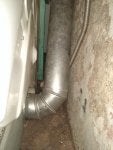hey guys;
My gas dryer (in the basement) has a piecemeal vent hookup.
I want to fix it so it meets local code. I live in the U.S.
I have posted several pictures of the current config, which I am certain does not meet code.
Several things I can point out immediately:
1. There is no secure means to attach the flexible hose to the pipe that goes through the wall to the outside vent hood. Note that this pipe is flush with the wall.
Originally, I believe there was a 90 elbow inserted into the wall pipe, but from the outline around the pipe (hole in the wall) there was once a flange mounted there. That said, there are no screw holes that would have been used to screw the flange to the wall.
I would assume that I need to secure the inside pipe/hose to the one through the wall by a clamp. My best guess is that i need to install a flange which would have a connection for the hose from the dryer.
2. I would also assume that I need an elbow (perhaps I can re-use at least part of the rigid pipe) coming out of the dryer, rather than connect flexible hose directly to it. My thinking is that without an elbow, the flex hose can easily get kinked and blocked.
So I guess what I really need to know is where I can use flexible hose, and what type of fittings I need to connect it properly at each end.
Also, what sort of support do I need?
Obviously, the wire now holding the pipe/hose is not code.
Images of current config:
![]()
Rigid pipe exits the dryer.
![]()
Flex pipe attached to rigid pipe
![]()
Flex pipe is stuck into pipe through wall using short rigid pipe with clamp
![]()
Flex pipe removed to show pipe through wall
Thanks for your help
Ultrarunner
![Image]()
![Image]()
My gas dryer (in the basement) has a piecemeal vent hookup.
I want to fix it so it meets local code. I live in the U.S.
I have posted several pictures of the current config, which I am certain does not meet code.
Several things I can point out immediately:
1. There is no secure means to attach the flexible hose to the pipe that goes through the wall to the outside vent hood. Note that this pipe is flush with the wall.
Originally, I believe there was a 90 elbow inserted into the wall pipe, but from the outline around the pipe (hole in the wall) there was once a flange mounted there. That said, there are no screw holes that would have been used to screw the flange to the wall.
I would assume that I need to secure the inside pipe/hose to the one through the wall by a clamp. My best guess is that i need to install a flange which would have a connection for the hose from the dryer.
2. I would also assume that I need an elbow (perhaps I can re-use at least part of the rigid pipe) coming out of the dryer, rather than connect flexible hose directly to it. My thinking is that without an elbow, the flex hose can easily get kinked and blocked.
So I guess what I really need to know is where I can use flexible hose, and what type of fittings I need to connect it properly at each end.
Also, what sort of support do I need?
Obviously, the wire now holding the pipe/hose is not code.
Images of current config:

Rigid pipe exits the dryer.

Flex pipe attached to rigid pipe

Flex pipe is stuck into pipe through wall using short rigid pipe with clamp

Flex pipe removed to show pipe through wall
Thanks for your help
Ultrarunner






